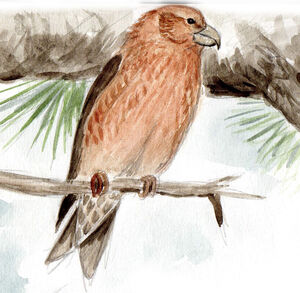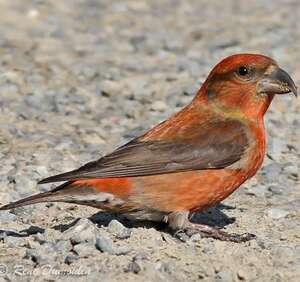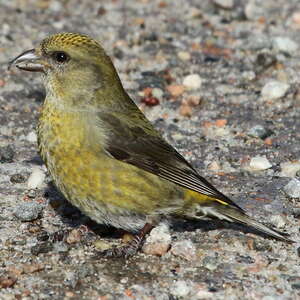Red Crossbill
Loxia curvirostra - Bec-croisé des sapins
Identification
Red Crossbills have the anatomical peculiarity of having an asymmetrical beak. The two parts cross at the end. It is an adaptation that allows them to extract seeds from conifer cones with the help of their tongue. The Red Crossbill has a long and well developed one. It also shows a significant sexual dimorphism. Males are brightly colored while females have cryptic plumage.
The adult male Red Crossbill in breeding plumage has the body plumage with an intense red-vermillion color when worn. The rump is the region where red is the most intense. The wings and tail are dark brown. There is no light bar in the wing. There are individual variations. Some males, probably partly in the 2nd year, appear orange in color, or even close to the color of the females.
The adult female appears yellow-green. Also here it is the rump, bright yellow, the most colorful part of the body, but hidden by the tip of the wings at rest. The yellow-green is not uniform but dotted, such as on the cap or mottled with gray on the lower parts. Some females are more gray overall. There are also individual variations here. Wings and tail are brownish, no wing bars. The small clawed legs are reddish or brownish.
The juvenile is recognized by its cold plumage, without color, and especially very spotted/striped with brown everywhere. The wing feathers, new, have pale edges, which creates a light bar effect on the big coverts, but not enough to be confused with a young bifascia. The beak is also paler. From the first winter, the young bird becomes female type. It can be distinguished from the adult female by the edgings that persist on the wing coverts.
Subspecific information 19 subspecies
- Loxia curvirostra curvirostra (n, w and c Europe to ne Siberia and n Mongolia)
- Loxia curvirostra balearica (c and s Spain, Balearic Is.)
- Loxia curvirostra corsicana (Corsica)
- Loxia curvirostra poliogyna (s Italy, nw Africa)
- Loxia curvirostra guillemardi (e Balkans and Turkey to the Caucasus and s Ukraine)
- Loxia curvirostra altaiensis (ne Kazakhstan, sw Siberia and w Mongolia)
- Loxia curvirostra tianschanica (se Kazakhstan to Tajikistan and nw China)
- Loxia curvirostra himalayensis (Himalayas to s China)
- Loxia curvirostra meridionalis (s Vietnam)
- Loxia curvirostra japonica (se Siberia, ne China, Korea, Sakhalin and Kuril Is. and Japan)
- Loxia curvirostra luzoniensis (Luzon. n Philippines.)
- Loxia curvirostra minor (se Canada and ne USA)
- Loxia curvirostra percna (Newfoundland)
- Loxia curvirostra sitkensis (coastal s Alaska to coastal w USA)
- Loxia curvirostra bendirei (inland sw Canada and inland nw USA)
- Loxia curvirostra benti (c Rocky Mts.. wc USA.)
- Loxia curvirostra grinnelli (wc to sw USA)
- Loxia curvirostra stricklandi (sw USA to s Mexico)
- Loxia curvirostra mesamericana (Guatemala and Belize to Nicaragua)
Foreign names
- Bec-croisé des sapins,
- Piquituerto común,
- cruza-bico-comum,
- Fichtenkreuzschnabel,
- keresztcsőrű,
- Kruisbek,
- Crociere,
- mindre korsnäbb,
- Grankorsnebb,
- krivonos smrekový,
- křivka obecná,
- Lille Korsnæb,
- pikkukäpylintu,
- trencapinyes comú,
- Krossnefur,
- krzyżodziób świerkowy,
- egļu krustknābis,
- krivokljun,
- Клёст-еловик,
- イスカ,
- 红交嘴雀,
- mindre korsnäbb,
- 紅交嘴雀,
Voice song and call
The call of the Red Crossbill is a deep, resonant 'tiup', which combines two different vowels. It is often repeated for lengthy periods at a moderate pace. It is also regularly heard during movements, serving as a contact call. It travels over long distances and makes possible the identification when migrating for example.
The song is a continuous, low-sounding potpourri, resembling a sub-song, made up of various notes; some melodic, others not so pleasant, and even at times, grating. It is understood that the song does not have the same purpose as it does with other species, where it is generally used to announce territory and therefore must be audible.
Habitat
The Red Crossbill is dependent on conifers for its food. It nests in natural or artificial coniferous forests, mainly in Pessières in Europe and Pin d'Alep pine groves in North Africa.
Behaviour character trait
The major physical characteristic of Crossbills is, as their name implies, their crossed bill, designed to extract the seeds of conifers, their main food, from the scales of the cones of these trees.
The Red Crossbill, contrary to what its name suggests, mainly feeds on Scandinavian Spruce Picea abies seeds in Europe. It climbs in the branches with the help of its feet and its bill, a bit like a parrot, and targets the cones. The cone is separated from the tree with considerable effort. Then, the bird carries it on a suitable branch, firmly holding it with its fingers, to extract each seed repeatedly. It starts at the bottom of the cone and spirals upwards, pushing with its bill to open each scale and retrieving the seed with its tongue. The scale is cut in the middle by the bill, which is the trademark of work of the Crossbill. A squirrel, for example, proceeds differently, it simply cuts the scale at its base with its incisors.Crossbills move according to food resources. They do it in small groups. They can suddenly leave a place if food becomes scarce. They reproduce when food is abundant and mature, at any month of the year for the whole species.
Flight
Dietfeeding habits
The Red Crossbill has a specialized diet. It mainly feeds on conifer seeds taken directly from the cones using its specially adapted bill.
The tongue plays an important role in that it collects the seed released by the mandibles. The size of the bill varies according to the subspecies and the size of the seeds they consume. A beautiful example of adaptation.It also marginally consumes other seeds, deciduous tree seeds (maples, birches, alders, elms, etc.), herbaceous seeds as well as some small invertebrates such as aphids or caterpillar larvae.
Reproduction nesting
The Red Crossbill is known to time its reproduction to the maturity of the coniferous seeds which it uses to feed its clutch.
The season is thus modifiable to some degree. It is also less entrenched within its territory than many other species. From year to year, the local situation can be vastly different and it will not hesitate to move in order to find suitable conditions for reproduction. In Europe, it is known to breed very early, at the end of the winter season, and so broods can be seen as early as springtime. However, in the Pyrenees, reproduction can occur as early as November when pinecones beginning to open, a sign of maturity.The nest is built by the female high up in a conifer, on a horizontal branch in a drooping vegetation or in a fork branching off multiple secondary branches. It is a bulky nest made up of twigs and conifer needles, grasses, pieces of bark and moss. The interior is lined with finer grasses, lichens, feathers and hairs. The female lays 3 to 4 white eggs stained green and heavily speckled brown at the large end. Incubation lasts for about 14 days, the female is fed by the male via regurgitation. The chicks are nidicolous and are fed by the male for the first five days and then by both parents. They leave the nest after 18 to 22 days and are still fed by the parents for a month. Their mandibles are not crossed at birth but only change shape with growth.
Geographic range
The Red Crossbill is a holarctic species boasting 22 subspecies. Ssp. nominale curvirostra alone has a range that extends from the British Isles and Spain to northeastern China and the extreme southeast of Russia in the Amur Region. Ssp. corsicana is resident in Corsica, balearica in Majorca, guillemardi from the Balkans to the Caucasus. 7 other ssp are seen in the south, east, and southeast of Asia. The ssp poliogyna of the Maghreb mountains perhaps deserves its own specific status. In North America, there exist 9 ssp. whose range is a reflection of the coniferous forests, therefore essentially limited to the west and northeast of the continent.
Threats - protection
IUCN conservation status
concern
in the Wild
threatened
evaluated
Currently, the Red Crossbill is common and widespread in its vast distribution area and the species is not globally threatened. It is evident that island populations are generally more vulnerable but this has not yet been documented.
The current climate change, which weakens coniferous populations and opens the way to its pests, can become a real problem for it.
Sources of information
- IOC World Bird List (v15.1), Gill, F and D Donsker (Eds). 2025-12-07.
- Finches and Sparrows, Peter Clement
- Les passereaux d'Europe, tome 2, P. Géroudet, M. Cuisin
- Avibase, Lepage Denis
- Birds of the World, The Cornell Lab of Ornithology
- xeno-canto, Sharing bird sounds from around the world,
Other sources of interest
 Specification sheet created on
24/07/2023 by Jean François
Specification sheet created on
24/07/2023 by Jean FrançoisTranslation by AI Oiseaux.net
© 1996-2025 Oiseaux.net
- Accipitriformes
- Aegotheliformes
- Anseriformes
- Apodiformes
- Apterygiformes
- Bucerotiformes
- Caprimulgiformes
- Cariamiformes
- Casuariiformes
- Charadriiformes
- Ciconiiformes
- Coliiformes
- Columbiformes
- Coraciiformes
- Cuculiformes
- Eurypygiformes
- Falconiformes
- Galliformes
- Gaviiformes
- Gruiformes
- Leptosomiformes
- Mesitornithiformes
- Musophagiformes
- Nyctibiiformes
- Opisthocomiformes
- Otidiformes
- Passeriformes
- Pelecaniformes
- Phaethontiformes
- Phoenicopteriformes
- Piciformes
- Podargiformes
- Podicipediformes
- Procellariiformes
- Psittaciformes
- Pterocliformes
- Rheiformes
- Sphenisciformes
- Steatornithiformes
- Strigiformes
- Struthioniformes
- Suliformes
- Tinamiformes
- Trogoniformes

































